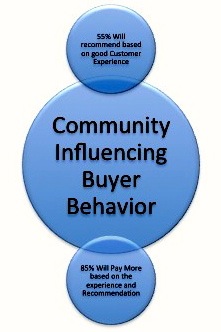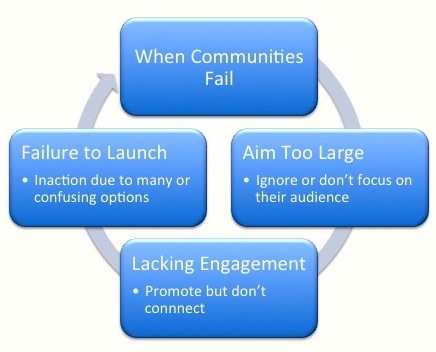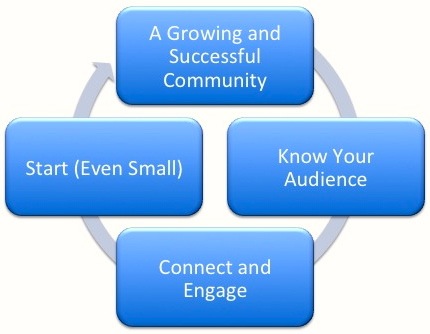They’re members of your community, right?
I’m certain that if I asked every CMO and marketing leader I know to describe their brand community, I would get a different answer from each. “Community” is a subjective concept, with wide varying definitions.
 There are also wide variations in how brands are seen, heard and felt by their respective communities. How deeply does a community feel connected to a brand?
There are also wide variations in how brands are seen, heard and felt by their respective communities. How deeply does a community feel connected to a brand?
For instance, think about Apple and its community. Apple gets attention because its brand recognition is extraordinary. But have you considered the powerful impact that Apple’s community has had on the success of the brand?
To demonstrate my point, think of the last conversation you’ve had with an “Apple fan” about the company, its products or its competitors. What did that conversation sound like?
If your experience is anything like mine, the conversation was probably wonderful, as long as you agreed about how wonderful Apple and its products are. However, if you dared to question the quality of Apple’s products, ideas or ability to innovate, you no doubt soon realized that you had crossed into enemy territory.
Those kind of conversations are a lot like telling your child that Santa isn’t real — only worse. But it speaks highly of the Apple community.
What is the catalyst for Apple’s insanely powerful connection with its community?
By-in-large, Apple doesn’t behave like a “nouveau” social company, so they’re not building their brand army through Facebook and Twitter. But it has brought together a passionate, global community by creating a sense of “belonging” that customers feel deeply when they use Apple products.
The iconic Apple slogan, “Think Different” epitomizes its cult-like following. On any given day at Starbucks around the world, people who want to be seen as broad-minded, creative thinkers are often found hovering over a Macbook — almost as if the presence of an Apple product is synonymous with their identity.
For Apple, this works. Through a customer experience focused on the idea that being different and innovative is “cool,” Apple has built one of the tightest brand communities on and off the web. But of course, Apple is a huge, established company, with a massive budget for community development. It leads me to wonder — how can other brands, smaller brands, newer brands tap into the power of community?
Not Just Community — A Close Community
Think about the neighborhood where you grew up. What was it like? Was it urban or rural? Were there many houses or just a few? Did you know your neighbors, or were they merely passing strangers?
Regardless of their shape, size and geography, most neighborhoods provide some sense of community. However, all neighborhoods aren’t the same. In my hometown, there was a “Community Center” — a place where folks from the neighborhood would congregate, connect and discuss issues affecting the area.
In that kind of environment, as citizens drew closer, the more they worked together to get things done — for example installing a stop sign where kids played in the street, and passing a referendum to build a new school. Over the years, as traditional urban settings gave way to modern models, subdivisions often created a community “on purpose,” with a Neighborhood Watch, a Board of Directors, and sometimes even a pool and recreation center.
This intentional approach to community brings stakeholders closer, by making neighborhood issues and events more visible, and helping community participants see the impact of their involvement.
Building a Brand Community Like a Neighborhood
When you boil it down to its simplest form, a community is the sum total of your brand stakeholders. I say stakeholder (rather than customer) because many people can participate in a brand community, beyond those who purchase a company’s products and services.
First, there are obvious extensions, such as employees and friends. Also, there are less obvious community players, such as those who are interested in learning more about your products and services, but may not have an immediate need to buy.
Let’s use automobiles as an example.
In 1995, when I was 14, my favorite car in the whole world was the new Pontiac Grand Prix. It had just been redesigned as a “wide track” model, and as a 14 year old, I thought it was one bad machine. However, at 14, I wasn’t legally or financially able to buy a car.
Four years later, I had scraped together all the loose change from under the sofa cushions, and I was ready to buy a car. Guess what I bought? The Grand Prix! That’s because I had emotionally tied myself to the brand, the car, and the community. When I was ready to purchase, it wasn’t even a question who would earn my business.
While my story is just one example, this type of brand loyalty exists with everything from the food we eat to the blue jeans we wear, and beyond. When people become a part of something, their purchasing sentiment changes. And guess what? So does the way they evangelize for your product. You think someone that likes your product is a good ambassador. Just think of someone who recently bought your product and likes it! That is another great frontier for brand building.
Which takes us back to building a close-knit community. It requires a setting for cultivation and nurturing. Much like a neighborhood — only different — to suit the needs of the brand and its community.
Community in the Connected World
If you think about the neighborhood example, you’ll likely think that a good community is small, tight knit, and somewhat directionally aligned.
But in the new world — the connected world where we manage communities on our blog, Facebook, Twitter and what seems like a million other places — the idea of community can become overwhelming. That’s because the “massiveness” of the online sphere is hard for many marketers to imagine in meaningful terms.
This can lead marketers to make some key community-building mistakes:
1) They aim too large: Mere numbers (pageviews, visits, likes, followers) aren’t relationships;
2) They don’t engage: Communicating with a “faceless” digital community can seem like a daunting task;
3) They miss out: Online communities are a powerful way to build influential brand advocates, but sometimes inaction takes over when brands don’t know where to start.
While these mistakes are typical, they can be avoided with a few common-sense tactics:
1) Aim for relevance: Rather than shooting for a large community, start by aiming for those that are most likely to buy your product/service now or in the near future. Also, with online networks (especially social networks), research where your target audience invests its time, and go there first!
2) Engage more than you promote: Share your stories, ideas and information, but make sure you allow the community to become part of the conversation. Ask more questions. Build more testimonials and case studies. Invite participation.
3) Start: Even if your “start” is small, don’t miss the opportunity to build a community by putting your head in the sand.
Remember: Building A Community Can Take Time
Apple has an amazing community of insanely loyal brand advocates. It also nearly crashed and burned on multiple occasions, and was saved by innovation that focused on consumption of music on a tiny MP3 player. For other companies, community takes time and work to build.
This starts at the core — building products and services that your customers can love. It also may include places for customers to congregate and talk about how they put your products to use.
On the flip side, community building also requires brands to acknowledge shortcomings and respond transparently when things go poorly. Think about what Target and Snap Chat will need to invest in rebuilding brand confidence after recent security breaches. Neither of these incidents was intentional, but trust was lost, and recovery will take time and monumental effort.
However, there is a certain beauty in community. When you build it, nurture it and engage with it, your community will tend to stand by your brand in good times and in bad. While never perfect — like your family, your neighborhood or your city — your brand community is one of the most powerful tools in the connected world.
Whatever you do, don’t ignore or underestimate the power of your community!
(Editor’s Note: Republished from Millennial CEO, with permission, this is an excerpt from “The New Rules of Customer Engagement,” a new ebook by Dan Newman, available Spring 2014. )
(Also Note: To discuss World of Work topics like this with the TalentCulture community, join our online #TChat Events each Wednesday, from 6:30-8pm ET. Everyone is welcome at events, or join our ongoing Twitter conversation anytime. Learn more…)
Image Credit: Texas A&M